Blogs

Understanding Nickel Iron Alloys: A Complete Tutorial on Properties and Applications
Introduction
In the realm of advanced materials, nickel iron alloys stand out for their exceptional properties and versatility across various industries. Characterized by a composition that typically includes a significant proportion of nickel and iron, these alloys offer remarkable magnetic permeability, ductility, and corrosion resistance, making them essential for applications ranging from electronics to aerospace.
As industries evolve and demand for high-performance materials increases, understanding the nuances of nickel iron alloys becomes imperative for procurement professionals. This article delves into the following aspects of nickel iron alloys:
- Composition
- Key properties
- Classifications
- Applications
- Future trends
Providing valuable insights for those looking to leverage these materials in their operations. With ongoing innovations and a growing emphasis on sustainability, the landscape of nickel iron alloys is set to transform, reinforcing their critical role in modern manufacturing and technology.
Introduction to Nickel Iron Alloys: Composition and Characteristics
These metal combinations, mainly made up of specific elements, display a variety of characteristics that are significantly affected by their particular composition. Typically, these mixtures preserve a composition of about 35% metal to 65% metal, although adjustments are customized for specific industrial uses. The key characteristics of nickel iron alloys include remarkable ductility, exceptional magnetic permeability, and notable corrosion resistance, making nickel iron alloys ideal for industries that demand precise magnetic properties.
For instance, cold rolled strip has a hardness of 100 Rockwell B, providing a quantitative measure of material properties relevant to these metals. Recent advancements in production techniques have further enhanced their performance, as highlighted by the DOMADIA Group, a trusted supplier of Nickel Molybdenum Iron Alloy and other special metals since 1952. Their commitment to sourcing excellence ensures that clients receive materials with superior characteristics.
The DOMADIA catalog showcases a range of special metals and combinations, including:
- Copper
- Titanium
- Rare Earths
These are designed to fulfill various industrial requirements. For instance, ZCMIM, a prominent MIM firm in China, highlights that ‘Debinding is a crucial process in MIM; it will create a porous, fragile brown part without deformation and defects,’ emphasizing the significance of manufacturing processes associated with iron-based materials. The inclusion of vanadium in Fe49Co49V2 composition has been shown to enhance ductility by inhibiting atomic ordering, a critical factor in maintaining material integrity under stress.
Furthermore, nickel-copper mixtures, referred to as MONEL NICORROS, usually possess at least 63% metal, which is crucial for uses needing exceptional strength and resistance to corrosion. Recent studies on Permalloy coatings—a type of soft magnetic coating—have focused on composition, microstructure, and deposition methods, illustrating advancements in the electrodeposition of permalloy. As industries advance, the use of nickel iron alloys keeps growing, emphasizing their significance in contemporary manufacturing, backed by the DOMADIA Group’s heritage of quality and performance.
We invite you to explore our extensive catalog to discover the full range of our offerings.
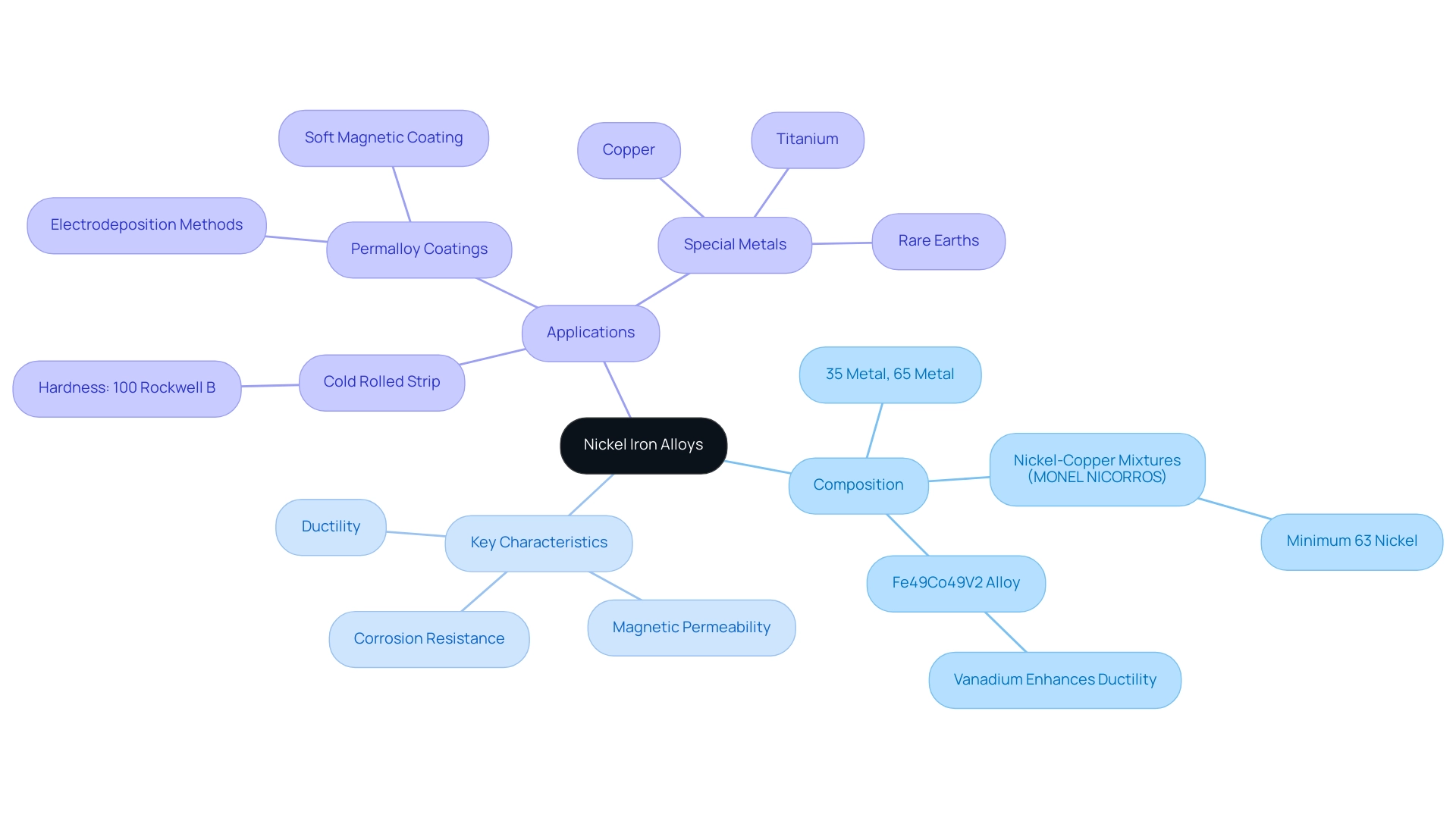
Key Properties of Nickel Iron Alloys: Magnetic and Mechanical Insights
Nickel iron alloys are characterized by their exceptional magnetic qualities, making them crucial for applications that require high magnetic permeability and low coercivity. These materials exhibit superior mechanical characteristics, such as exceptional tensile strength and fatigue resistance. Notably, their ability to retain these properties at elevated temperatures significantly broadens their applicability across various industrial sectors.
Recent advancements in research highlight that Group 5 alloys, known for their nickel-rich composition, lack coherent precipitates and derive their strength from carbides, nitrides, and carbonitrides. Their operational limits for nonstressed uses reach up to 1093°C (2000°F), underscoring their utility in high-temperature environments. Likewise, Domadia’s Mica Tapes offer high-temperature electrical insulation solutions, essential for important uses in electrical engineering.
With superior insulation properties, featuring excellent flame resistance and dielectric strength, Mica Tapes guarantee reliability and durability in various uses, from household appliances to industrial machinery. As Bertotti Fiorillo expresses, ‘The interaction between mechanical and magnetic characteristics in nickel iron alloys is a key interest for material scientists aiming to enhance performance in real-world uses.’ Additionally, the chemical synthesis of FeNi materials, as examined in numerous case studies, highlights different techniques such as reduction from solution and electrodeposition, which facilitate control over composition and characteristics, allowing for the development of substances customized for particular magnetic uses.
Additionally, findings from Amaliya et al. concerning the structural, electrical, and magnetic characteristics of titanium substituted cobalt ferrite nanocrystallites offer a wider framework for comprehending the magnetic properties pertinent to other metal combinations. For engineers and procurement professionals, a thorough understanding of these properties, alongside reliable insulation solutions like Mica Tapes, is crucial when evaluating materials for specific uses.
We invite you to explore our range of Mica Tapes and contact our expert team today to ensure your selection aligns with both performance requirements and industry standards. Join the ranks of satisfied customers who trust Domadia for their high-temperature electrical insulation needs.
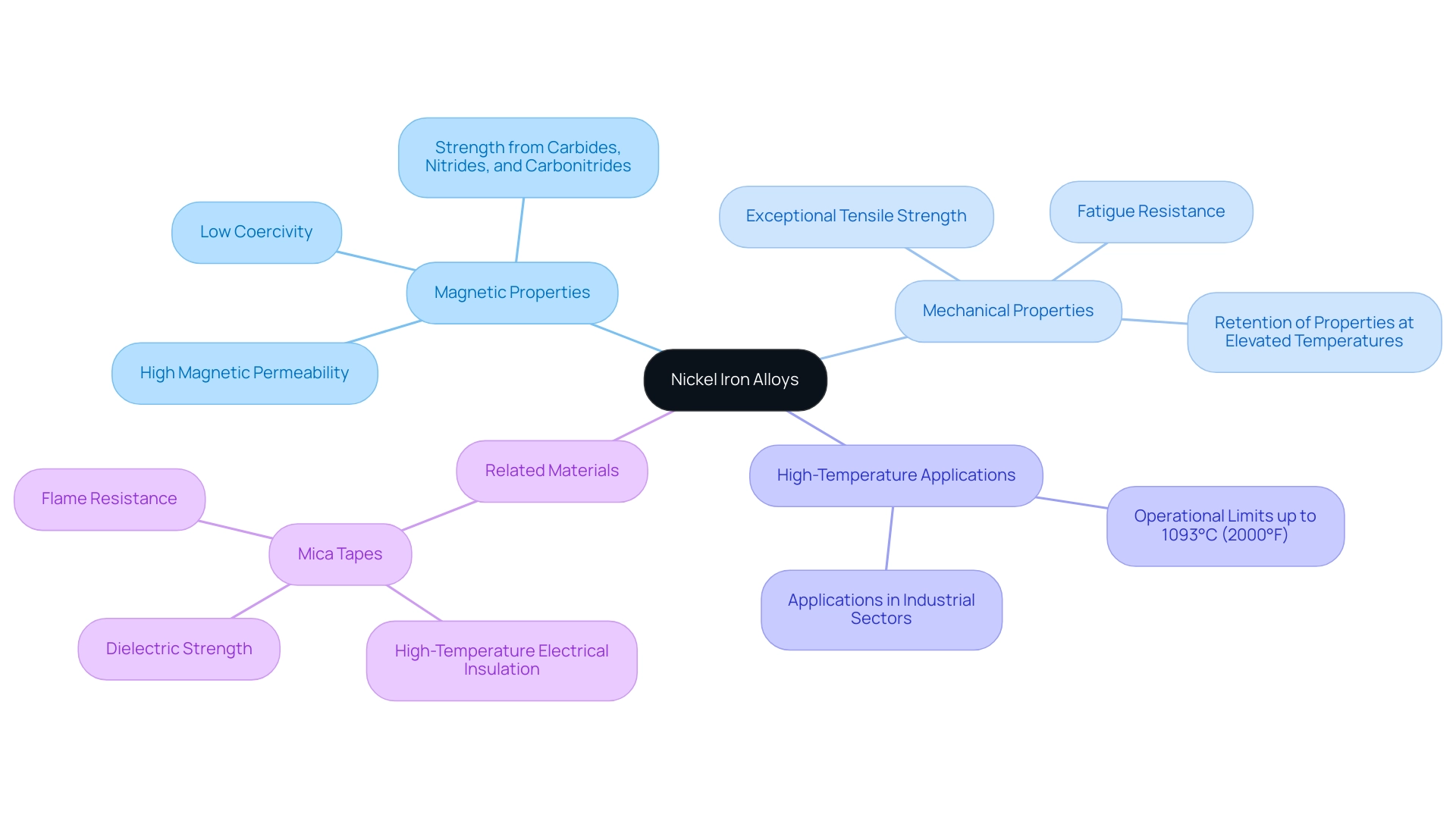
Types of Nickel Iron Alloys: A Comprehensive Overview
Nickel metal mixtures are categorized into various unique types, each defined by its composition and particular uses. A primary example is Permalloy, which typically contains approximately 80% of one metal and 20% iron. This mixture is notably acknowledged for its high magnetic permeability and low hysteresis loss, making it especially appropriate for transformer cores and magnetic shielding uses.
Another important type is Mu-Metal, which contains approximately 77% of a specific metal. This metal excels in offering outstanding magnetic shielding characteristics, frequently used in numerous electromagnetic interference (EMI) shielding applications.
Iron-Nickel 36 (Invar), comprising 36% of this element, is noted for its low thermal expansion coefficient. This property makes it perfect for precision instruments and uses that require dimensional stability across different temperatures.
Alongside these categories, it is crucial to take into account the wider context of iron-based materials in several industries. For example, Alloy 400 (UNS N04400) is frequently utilized in marine and chemical processing settings, emphasizing the versatility and significance of nickel-based materials in challenging environments. Meanwhile, copper-based materials are particularly beneficial in marine engineering due to their superior corrosion resistance compared to stainless steel, making them ideal for components such as ship hulls and seawater piping systems.
Their excellent performance in automotive systems for brake lines and hydraulic uses, along with their role in electronics and heat exchangers, further showcases their versatility across multiple sectors. In electronics, copper and nickel-containing materials are utilized for connectors and circuit boards, while in heat exchangers, they provide efficient thermal conductivity and resistance to fouling.
As noted by the Institute of Materials Engineering Australasia, ‘The unique properties of nickel iron alloys make them indispensable in modern engineering applications.’ Similarly, the advantages of copper nickel mixtures in electronics and heat exchangers further illustrate their critical role in contemporary engineering, particularly their capacity to endure corrosive environments where stainless steel may falter.
Understanding the nuances of these classifications is crucial for procurement professionals, as it enables them to select the most suitable material for their specific project requirements, ensuring optimal performance and reliability. Furthermore, drawing parallels with stainless steel compositions, such as 316L, which offers greater resistance to chlorides and is used in coastal regions and chemical processing, underscores the importance of corrosion resistance and strength in material selection.
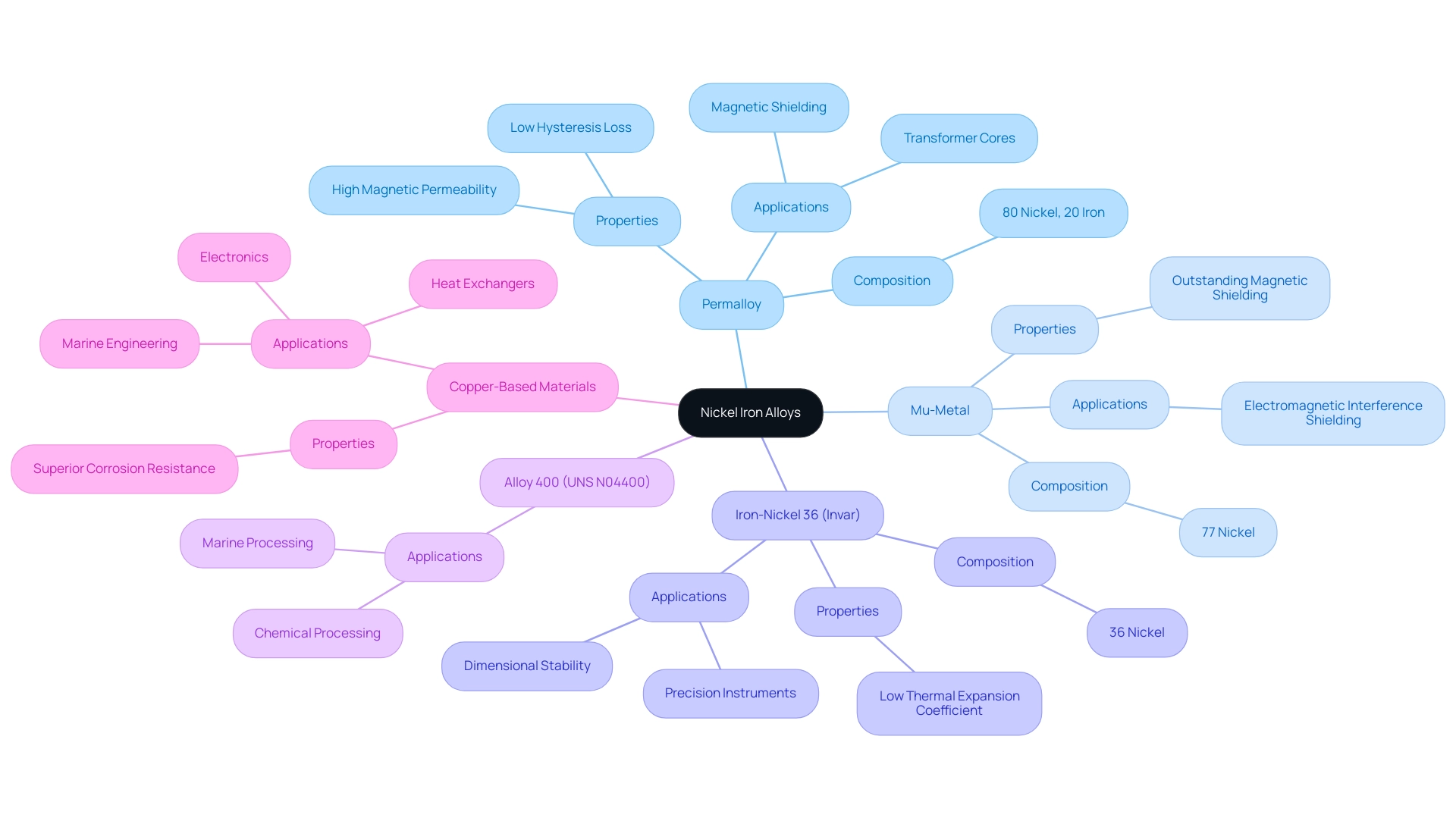
Applications of Nickel Iron Alloys: From Electronics to Aerospace
Nickel metal mixtures are essential to many industries, renowned for their distinctive characteristics that satisfy the requirements of sophisticated uses. Their key applications include:
Electronics: Nickel iron alloys are extensively utilized in components like inductors, transformers, and magnetic shielding devices. Their exceptional magnetic properties facilitate efficient performance in electronic circuits, making them indispensable in modern technology.
Automotive: In the automotive sector, these materials play a crucial role in sensors and electrical components. Their ability to deliver superior magnetic performance ensures optimal functionality in various vehicle systems, enhancing both safety and efficiency.
Aerospace: The aerospace sector utilizes iron-based materials in specialized equipment that requires high strength-to-weight ratios and stability under extreme conditions. Recent advancements indicate the establishment of thermomagnetic anisotropy through magnetic annealing, which is vital for achieving a square hysteresis loop in materials containing 55–65% of a certain metal. This characteristic is particularly beneficial for applications where precision and reliability are paramount.
Medical Devices: In the medical field, iron-based materials are essential in MRI machines and various diagnostic equipment. Their magnetic properties are crucial for ensuring the accuracy and effectiveness of these technologies, underscoring their role in advancing healthcare solutions.
Energy Sector: Furthermore, certain metal mixtures are employed in wind turbines and solar panels because of their resistance to corrosion and longevity. These properties are essential for maintaining performance and longevity in renewable energy uses.
These varied uses not only emphasize the significance of nickel iron alloys in contemporary technology but also showcase the versatility and dependability of these alloys across essential sectors. As Bertotti Fiorillo observes, “the strategic application of these materials is crucial for addressing the evolving needs of various industries.
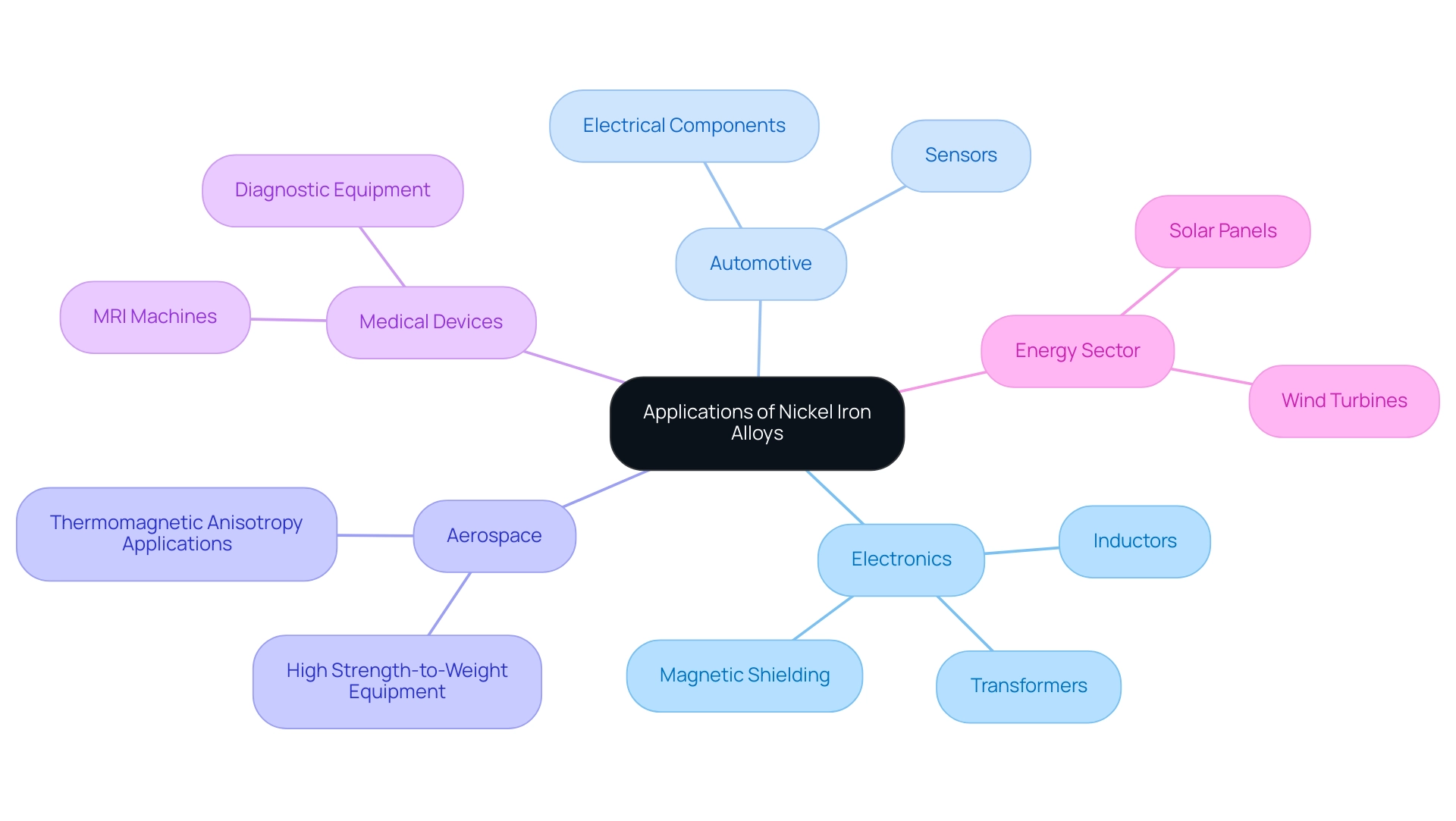
Future Trends in Nickel Iron Alloys: Innovations and Advancements
The prospects of metal mixtures are set for considerable progress, backed by continuous studies focused on improving their characteristics and expanding their uses. Notable trends include:
- Advanced Processing Techniques: Innovations such as additive manufacturing are set to revolutionize the production of nickel iron alloys, leading to superior performance characteristics that meet the evolving needs of various industries.
- Sustainability Initiatives: The growing consumer interest in sustainable materials is fueling research into the recycling and environmentally responsible sourcing of metal composites.
This shift not only addresses ecological concerns but also aligns with corporate sustainability goals.
– Corrosion-Resistant Segment Leadership: In 2023, the corrosion-resistant segment dominated the market for nickel-based materials, propelled by their use in marine products. This trend is crucial for procurement managers to consider when sourcing materials.
As sectors such as renewable energy and advanced electronics continue to expand, the integration of nickel iron alloys is expected to play a pivotal role in developing new technologies. Their unique properties will be integral to enhancing efficiency and performance in these applications.
For procurement managers, understanding and adapting to these trends is crucial for making informed strategic decisions that align with industry advancements and future market demands.
As noted in recent discussions, resolving conflicts and building a positive atmosphere in virtual team meetings can enhance collaboration in procurement processes, ensuring that teams are well-prepared to respond to evolving industry trends.
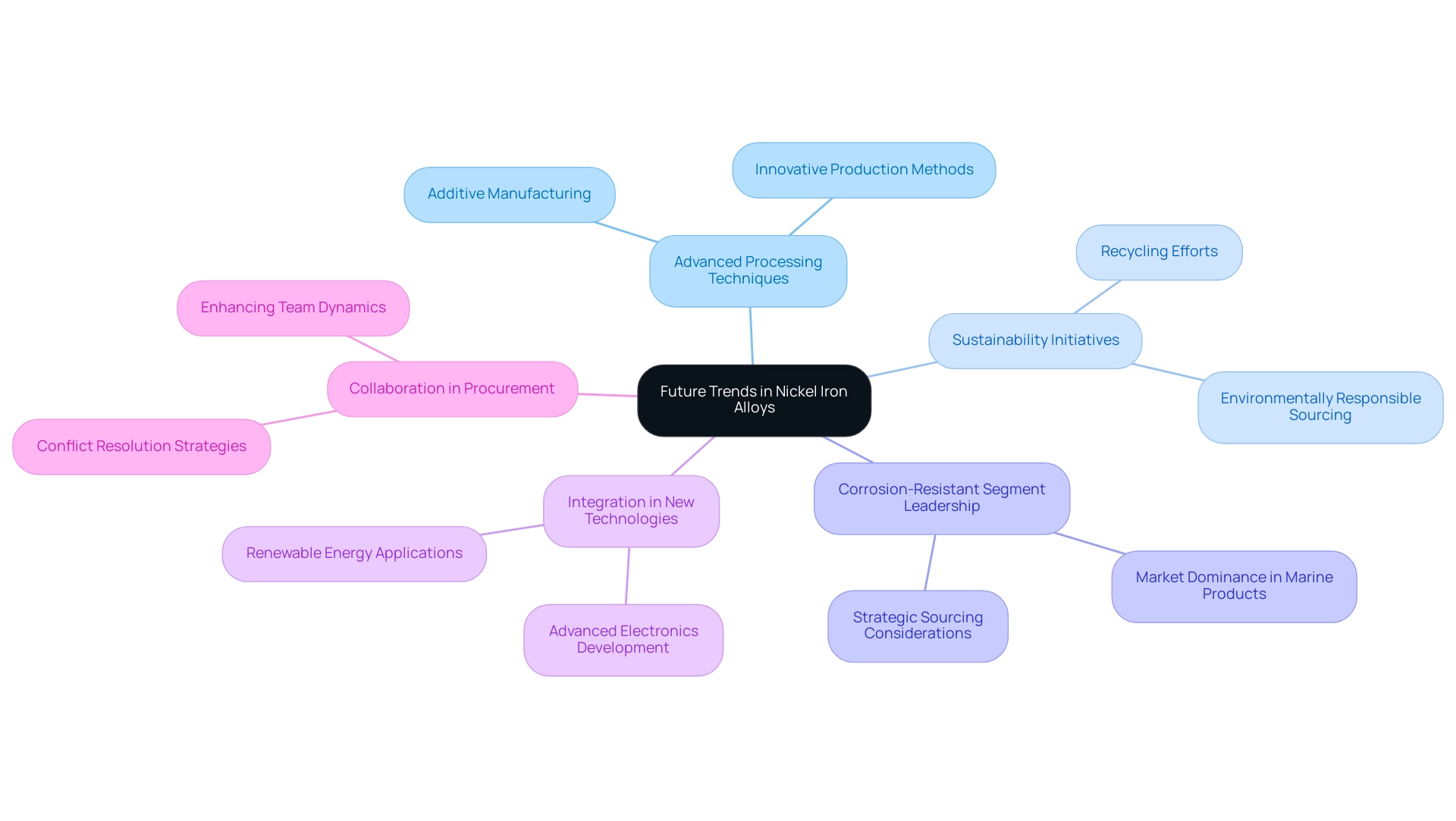
Conclusion
Nickel iron alloys embody a remarkable blend of properties that cater to the diverse needs of modern industries. Their unique composition, primarily consisting of nickel and iron, results in exceptional magnetic permeability, ductility, and corrosion resistance. These attributes make them indispensable across various sectors, from electronics and automotive to aerospace and renewable energy. Understanding the classifications and applications of these alloys is vital for procurement professionals, enabling them to select materials that ensure optimal performance and reliability for their specific needs.
As industries continue to evolve, the future of nickel iron alloys is bright, marked by innovations in processing techniques and a growing emphasis on sustainability. The ongoing research and development efforts are set to enhance the properties of these alloys, ensuring they remain at the forefront of advanced material solutions. The integration of nickel iron alloys into emerging technologies further underscores their critical role in driving efficiency and performance across multiple applications.
In conclusion, nickel iron alloys are not just materials of choice; they are essential components that support the advancement of technology and industry. With a keen understanding of their properties and trends, procurement professionals can strategically leverage these alloys to meet the demands of a rapidly changing market landscape. Investing in nickel iron alloys today will pave the way for future innovations and sustainable practices in manufacturing and technology.




